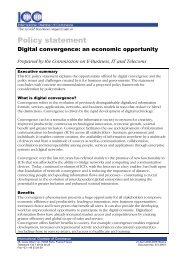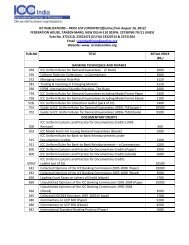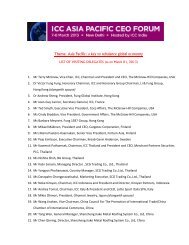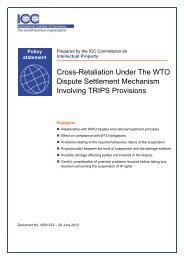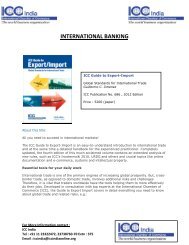2013 - ICC India
2013 - ICC India
2013 - ICC India
- No tags were found...
You also want an ePaper? Increase the reach of your titles
YUMPU automatically turns print PDFs into web optimized ePapers that Google loves.
28<strong>ICC</strong> BANKING COMMISSION | <strong>2013</strong> GLOBAL RISKS TRADE FINANCE | ANALYSIS OF MEDIUM AND LONG-TERM PRODUCTS4.2. TENORAs mentioned, a crucial factor of the risk characteristics of medium andlong-term ECA-backed products is their longer tenor at the point of signing.Figure 22 shows this across asset classes.FIGURE 22Tenor by asset class, 2006-11TENOR (YEARS)Corporate 9.6FI 11.8Sovereign 12.7Specialised 12.3Total 11.14.3. ECONOMIC LOSSIn estimating economic loss, we could base this, within our data set, solelyon the observed recoveries achieved on transactions that default. Thiswould reflect the amount of recoveries between the point of default andthe end of 2011, and should include both interest and principal payments.However, the nature of the ECA insurance/guarantee for most transactions(i.e. that the ECA will make repayments in line with the original schedule forthe transaction over the remaining maturity of the product), combined withour limited outcome window for defaults (less than six years in general) andthe long average tenor of exposures, means that we may miss a significantproportion of recoveries, leading us to underestimate the recoveries oroverestimate the LGD.To see the potential impact of this, consider a simple example:■■■■■■■■■■Consider a transaction that defaults in 2010 with 95% ECA coverage andexposure of US$50 million which is due to repay US$10 million per yearover the next five years.Under the terms of a typical ECA contract, the ECA would make apayment of US$9.5 million per year for five years to the bank (as thecontracts typically make good payments in line with the original loan,reflecting its amortisation profile 35 ).However, in our data we would only have captured recoveries from twoyears (i.e. 2 x US$9.5 million = US$19 million).Therefore, in our data, this customer would have an observed recoveryrate of 38% (=19/50).However, by the end of the original term, we will have received fivepayments each of US$9.5 million from the ECA, so the “expected”recovery would be 95% (=47.5/50).Given that we have included incomplete cases 36 , and given the natureof the ECA coverage, we expect the observed recoveries to consistentlyunderestimate the eventual recoveries and hence overestimate the eventualLGD. We have therefore also calculated the amount of recoveries thatwould be expected if the ECA were to make its payments as expected(i.e. we assume that the recoveries reflect the percentage coverage of theECA insurance).



